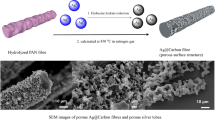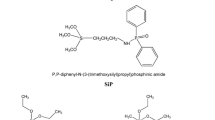Abstract
Novel fibre–silica–Ag composites with biocidal activity were successfully produced by chemical modifying cotton (CO), wool (WO), silk (SE), polyamide (PA) and polyester (PES) fabrics and CO/PES and WO/PES fabric blends. A silica–Ag coating was prepared using a two-step procedure that included the creation of a silica matrix on the fibre surface via the application of an inorganic–organic hybrid sol–gel precursor [reactive binder (RB)] using a pad-dry-cure method, followed by the in situ synthesis of AgCl particles within the RB-treated fibres from solutions of 0.10 mM and 0.50 mM AgNO3 and NaCl. The presence of the coating on the fibres was verified by scanning electron microscopy and energy-dispersive X-ray spectroscopy. The bulk concentration of Ag in the coated fibres was determined using inductively coupled plasma mass spectroscopy. The antimicrobial activity was determined for the bacteria Escherichia coli and Staphylococcus aureus and the fungus Aspergillus niger. The results show that the chemical and morphological structures of the fibres directly influenced their absorptivity and affinity for the Ag compound particles. As the amorphous molecular structure of the fibres and the amount of functional groups available as binding sites for Ag+ were increased, both the silver solution uptake and the concentration of the absorbed Ag compound particles increased. The chemical binding of Ag to the fibres significantly reduced the effectiveness of the antimicrobial activity of the Ag compound particles. Accordingly, an increase in the concentration of absorbed Ag was required to achieve a biocidal effect.




Similar content being viewed by others
References
Dastjerdi R, Montazer M (2010) A review on the application of inorganic nano-structured materials in the modification of textiles: focus on anti-microbial properties. Colloids Surf B 79:5–18
Simončič B, Tomšič B (2010) Structures of novel antimicrobial agents for textiles: a review. Text Res J 80:1721–1737
Radetić M (2013) Functionalization of textile materials with silver nanoparticles. J Mater Sci 48:95–107
Schindler WD, Hauser PJ (2004) Chemical finishing of textiles. Woodhead Publishing Ltd, Cambridge
Hoefer D, Hammer TR (2011) Antimicrobial active clothes display no adverse effects on the ecological balance of the healthy human skin microflora. ISRN Dermatol. article ID 369603, 8 pages
Eckhardt S, Brunetto PS, Gagnon J, Priebe M, Giese B, Fromm KM (2013) Nanobio silver: its interaction with peptides and bacteria, and its uses in medicine. Chem Rev 113:4708–4754
Lansdown ABG (2010) Silver in healthcare: its antimicrobial efficacy and safety in use. The Royal Society of Chemistry, Cambridge
Morones JR, Elechiguerra JL, Camacho A, Holt K, Kouri JB, Ramírez JT, Yacaman MJ (2005) The bactericidal effect of silver nanoparticles. Nanotechnology 16:2346–2353
Panáček A, Kvítek L, Prucek R, Kolář M, Večeřová R, Pizúrová N, Sharma VK, Nevečná T, Zbořil R (2006) Silver colloid nanoparticles: synthesis, characterization, and their antibacterial activity. J Phys Chem B 110:16248–16253
Martínez-Castañón GA, Niño-Martínez N, Martínez-Gutierrez F, Martínez-Mendoza JR, Ruiz F (2008) Synthesis and antibacterial activity of silver nanoparticles with different sizes. J Nanopart Res 10:1343–1348
Tomšič B (2009) Influence of particle size of the silver on bactericidal activity of the cellulose fibres. Tekstilec 52:181–194
Sotiriou GA, Pratsinis SE (2010) Antibacterial activity of nanosilver ions and particles. Environ Sci Technol 44:5649–5654
Lu Z, Rong K, Li J, Hao Yang, Chen R (2013) Size-dependent antibacterial activities of silver nanoparticles against oral anaerobic pathogenic bacteria. J Mater Sci 24:1465–1471. doi:10.1007/s10856-013-4894-5
Dubas ST, Kumlangdudsana P, Potiyaraj P (2006) Layer-by-layer deposition of antimicrobial silver nanoparticles on textile fibers. Colloids Surf A 289:105–109
Perelshtein I, Applerot G, Perkas N, Guibert G, Mikhailov S, Gedanken A (2008) Sonochemical coating of silver nanoparticles on textile fabrics (nylon, polyester and cotton) and their antibacterial activity. Nanotechnology 19(24):245705
Tomšič B, Simončič B, Orel B, Žerjav M, Schroers H, Simončič A, Samardžija Z (2009) Antimicrobial activity of AgCl embedded in a silica matrix on cotton fabric. Carbohydr Polym 75:618–626
Zhu C, Xue J, He J (2009) Controlled in situ synthesis of silver nanoparticles in natural cellulose fibers toward highly efficient antimicrobial materials. J Nanosci Nanotechnol 9:3067–3074
Ali SW, Rajendran S, Joshi M (2011) Synthesis and characterization of chitosan and silver loaded chitosan nanoparticles for bioactive polyester. Carbohydr Polym 83:438–446
Gorjanc M, Kovač F, Gorenšek M (2012) The influence of vat dyeing on the adsorption of synthesized colloidal silver onto cotton fabrics. Text Res J 82:62–69
Zhang D, Toh GW, Lin H, Chen Y (2012) In situ synthesis of silver nanoparticles on silk fabric with PNP for antibacterial finishing. J Mater Sci 47:5721–5728. doi:10.1007/s10853-012-6462-7
Klemenčič D, Tomšič B, Kovač F, Simončič B (2012) Antimicrobial cotton fibres prepared by in situ synthesis of AgCl into a silica matrix. Cellulose 19:1715–1726
Shastri JP, Rupani MG, Jain RL (2012) Antimicrobial activity of nanosilver-coated socks fabrics against foot pathogens. J Text Inst 103:1234–1243
Shinde VV, Jadhav PR, Kim JH, Patil PS (2013) One-step synthesis and characterization of anisotropic silver nanoparticles: application for enhanced antibacterial activity of natural fabric. J Mater Sci 48:8393–8401. doi:10.1007/s10853-013-7651-8
Klemenčič D, Tomšič B, Kovač F, Žerjav M, Simončič A, Simončič B (2013) Antimicrobial wool, polyester and a wool/polyester blend created by silver particles embedded in a silica matrix. Colloids Surf B 111:517–522
Tang B, Kaur J, Sun L, Wang X (2013) Multifunctionalization of cotton through in situ green synthesis of silver nanoparticles. Cellulose 20:3053–3065
Milošević M, Radoičić M, Šaponjić Z, Nunney T, Marković D, Nedeljković J, Radetić M (2013) In situ generation of Ag nanoparticles on polyester fabrics by photoreduction using TiO2 nanoparticles. J Mater Sci 48:5447–5455. doi:10.1007/s10853-013-7338-1
Klemenčič D, Muha P, Klepacka W, Tomšič B, Demšar A, Aneja AP, Žagar K, Simončič B (2013) Influence of the preparation procedure of colloidal silver solution on the properties of fibres from polylactic acid. Tekstilec 56:302–311
Kissa E (1984) In: Lewin M, Sello SB (eds) Handbook of fiber science and technology: Volume II, chemical processing of fibers and fabrics: functional finishes, Part B. Marcel Dekker, New York
Rippon JA (1992) In: Lewis DM (ed) Wool dyeing. Society of Dyers and Colourists, Bradford
Collier BJ, Tortora PG (2001) Understanding textiles, 6th edn. Prentice-Hall, New Jersey
Cook JG (1993) Handbook of textile fibres I. Natural fibres, 5th edn. Merrow Publishing Co. Ltd, Durham
Cook JG (1993) Handbook of textile fibres II. Man-made fibres, 5th edn. Merrow Publishing Co. Ltd, Durham
Sumner HH (1989) In: Johnson A (ed) The theory of coloration of textiles, 2nd edn. Society of Dyers and Colourists, Bradford
Hearle JWS (2001) In: Woodings C (ed) Regenerated cellulose fibres. The Textile Institute, Woodhead Publishing Limited, Cambridge
Barani H, Montazer M, Samadi N, Toliyat T (2012) In situ synthesis of nano silver/lecithin on wool: enhancing nanoparticles diffusion. Colloid Surf B 92:9–15
Tomšič B, Jerman I, Orel B, Simončič B (2011) Efficiency of silver based antimicrobial finish on cellulose fibres: covalently versus physically bonded silver. In: Adolphe D (ed) 150 years of research and innovation in textile science, Book of proceedings of 11th World Textile Conference AUTEX. Mulhouse, France, pp 1062–1068
Acknowledgements
This work was supported by the Slovenian Research Agency (Programme P2-0213, Research Infrastructure Centre UL–NTF and a grant for Ph.D. student D. K.).
Author information
Authors and Affiliations
Corresponding author
Rights and permissions
About this article
Cite this article
Klemenčič, D., Tomšič, B., Kovač, F. et al. Preparation of novel fibre–silica–Ag composites: the influence of fibre structure on sorption capacity and antimicrobial activity. J Mater Sci 49, 3785–3794 (2014). https://doi.org/10.1007/s10853-014-8090-x
Received:
Accepted:
Published:
Issue Date:
DOI: https://doi.org/10.1007/s10853-014-8090-x




